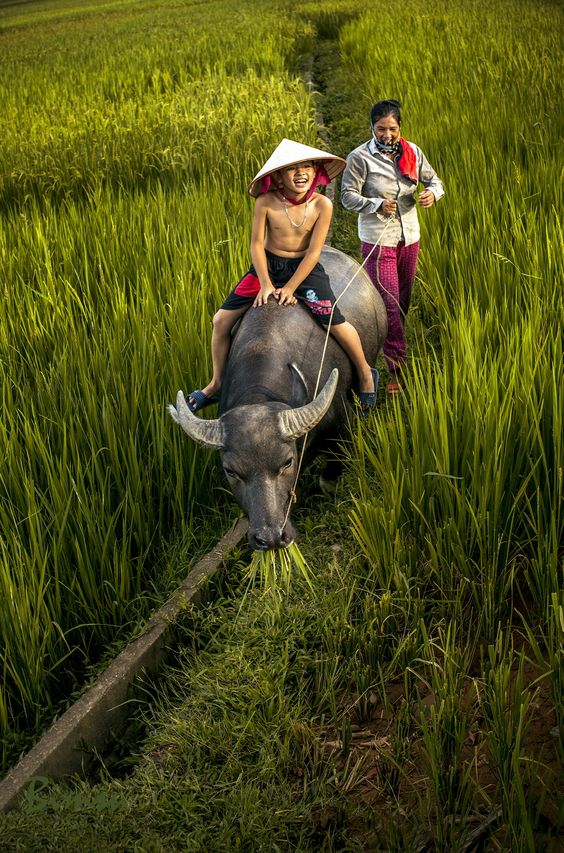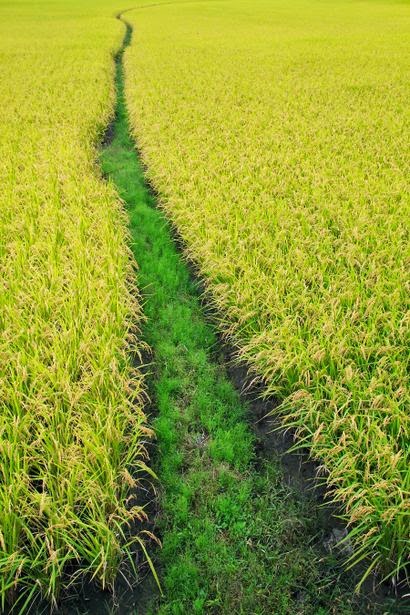 |
| Asian agriculture |
Land constraints and growing population and urbanization throughout Asia underscore the need for environmentally sound technologies to sustain agricultural growth.
The first agricultural revolution occurred in Asia and involved the domestication of plants and animals. It is believed that vegeculture first developed in Southeast Asia more than eleven thousand years ago. In vegeculture, a part of a plant—other than the seed—is planted for reproduction.
The first plants domesticated in Southeast Asia were taro, yam, banana, and palm. Seed agriculture, now the most common type of agriculture, uses seeds for plant reproduction. It originated in the Middle East about nine thousand years ago, in the basins of the two major rivers of present-day Iraq, the Tigris and the Euphrates.
  |
Wheat and barley were probably the first crops cultivated there. Although many plants were domesticated simultaneously in different parts of the world, rice, oats, millet, sugarcane, cabbage, beans, eggplant, and onions were domesticated originally in Asia.
Asia supports about 60 percent of the global population on only about 23 percent of the world’s agricultural land. As a result, Asian agriculture is far more intensive than on any other continent. Despite the population pressure on arable land, Asia has made remarkable progress in agricultural productivity.
Between 1966 and 1995, wheat production grew 5.5 percent annually, and rice production 2.2 percent. In Asia as a whole, food production has out-paced the growth of population. In most Asian countries, particularly in the low-income countries of South Asia, per-capita food availability has risen.
Agrarian Structure
Most people in Asia are farmers, owning an average of about 2.5 acres (1 hectare) of land per family. Topographic and climatic conditions, to a large extent, determine farm size. Agricultural potential is limited in Nepal, for example, because of the Himalaya Mountains, and in Saudi Arabia because of the Arabian Desert. In these countries, average farm size is larger relative to countries like Bangladesh, which contains a vast, fertile floodplain and receives abundant rainfall.
 |
| Indonesian Rice Field |
Another feature of Asian agrarian structure is the inequitable distribution of farmland. For example, in India more than 25 percent of cultivated land is owned by less than 5 percent of farming families.
Farm holdings in most Asian countries are highly fragmented, and tenancy is widespread. Fragmentation of farms inhibits agricultural mechanization, and land consolidation efforts have had limited success in most Asian countries.
Most Asian farmers are subsistence farmers, cultivating crops for family consumption. Almost all farm operations are done manually or with the help of draft animals. Exceptions are found in Japan, South Korea, and Taiwan, where small-scale equipment similar to garden tractors is widely used.
Only recently have Asian farmers started to use chemical fertilizer; for water, they largely depend on rain. As a result, yields are low, which compels farmers to cultivate the land intensively. Double-cropping is the norm; some farmers grow three crops a year.
Therefore, only a small fraction of the arable land in humid regions of Asia remains fallow. Farming is labor-intensive, and the extended family is the main source of labor. This helps to explain why family size is generally large in agrarian countries of Asia.
Rice and Wheat
 |
| Rice fields |
The coastal areas and inland river valleys of East, Southeast, and South Asia are the agricultural cores of the continent. More than half of the crop area of these regions is used to cultivate food crops such as rice and wheat. Rice is the principal food crop of all Asian countries located east and north of India and for the people of southern and eastern India.
Rice is the staple food of more than half of the world’s population, and 90 percent of it is grown in coastal and deltaic plains and in the river valleys of Monsoon Asia. This region encompasses a broad geographic area characterized by a distinctive climate, stretching from Japan in the east, through Indonesia in the south, and west to Pakistan. Rice farming there is practiced mostly at the subsistence level, using traditional methods.
Wheat is the primary food crop of northern and western India and all Asian countries located west of India. People of the wheat-producing region consume rice as a secondary staple. Eighteen of the twenty-five top rice-producing countries of the world are in Asia. India has the largest area devoted to rice cultivation of the world’s countries, but China is first in total production. Indonesia and Bangladesh rank third and fourth in world rice production.
With the exceptions of Japan, South Korea, China, and Taiwan, yields of all crops—particularly rice and wheat—are low in Asia compared to world standards. Although crop yields increased significantly after 1970, typical yields in Asia remained low for several reasons: Fertilizer use and the area under irrigation are among the lowest in the world.
Also, most Asian farmers practice traditional farming methods, where high yields are a typical. Another major obstacle to increasing crop yields is the preponderance of small farms. Because small farms do not have access to assured irrigation and cannot afford modern agricultural inputs, their average yield is generally much lower than that of medium and large farms.
Slash-and-Burn Agriculture
 |
| Slash-and-Burn Agriculture |
In the tropical rain forests of Southeast Asia, the mountainous and hilly parts of South Asia, and in southern China, a type of primitive agriculture known as shifting cultivation or slash-and-burn agriculture is practiced. Shifting cultivators plant different crops, such as rice, corn, millet, yams, sugarcane, oilseeds, potatoes, taro, vegetables, and cotton, on one site.
These farmers must abandon their fields and establish new ones every few years. As a result, a large area of land is required to support a small population. The land devoted to shifting cultivation is declining at a rapid rate worldwide because of the demand for forest resources for other uses.
Dry Agriculture
 |
| Dry Agriculture |
Farmers in the colder, drier parts ofAsia (northeastern China, northern Japan, southeastern East Asia, northeastern Southeast Asia, and the western half of South Asia) and the river valleys of the Middle East practice a system of intensive subsistence agriculture called peasant grain-and-livestock farming, or dry agriculture. The dominant grain crops are wheat, barley, sorghum, millet, oats, and corn, while cotton, tobacco, and sugarcane are grown as cash crops.
In arid areas, such as the Middle Eastern river valleys, irrigation helps support dry farming. Traditional water-lifting devices, such as the shaduf (a counterweighted, lever-mounted bucket), and the naria (waterwheel), permit limited double-cropping in the dry season near the rivers of the Middle East.
In the arid and semiarid parts of South Asia and the Middle East, and in the dry and cold western two-thirds of East Asia, nomadic herders graze cattle, sheep, goats, and camels. Nomadic herders move from place to place with their livestock in search of forage. As in other places, nomadic herding is declining in Asia.
Mediterranean Agriculture
A distinctive type of subsistence agriculture, called Mediterranean agriculture, is practiced along the Mediterranean coast of the Middle East and in the northern part of Turkey that borders the Black Sea. Traditional Mediterranean agriculture is based on wheat and barley cultivation in the rainy winter season. Farmers of this region also cultivate vine and tree crops, such as grapes, olives, and figs, and raise small livestock.
Export Crops
 |
| Export Crops |
Plantation crops such as tea, rubber, coconuts, and coffee are grown in Asia. Tea is indigenous to China, which is the world’s largest producer, followed by India, Sri Lanka, and Bangladesh. Tea is Sri Lanka’s largest export crop, accounting for about one-third of annual exports by value.
Tea is grown in the central highlands of Sri Lanka and in the hilly regions of northeastern India and Bangladesh. Rubber is grown in Malaysia and Indonesia—which account for about 75 percent of total world production—and Cambodia, India, and Sri Lanka. Malaysia, Indonesia, and Sri Lanka are world-leading exporters of coconuts and coconut products.
Green Revolution
A dramatic growth in food production in Asia began with the Green Revolution in the late 1960’s, particularly for wheat and rice. Cultivation of the new varieties of rice and wheat caused an impressive increase in the use of fertilizer and the expansion of irrigation, particularly the exploitation of groundwater through tube wells. With proper and timely application of fertilizers and water, yields of wheat can be tripled, and yields of rice can be doubled.
Critics of the Green Revolution have concentrated on the negative impacts of increased use of fertilizer and pesticides, which causes surface water pollution.With high-yield seeds, three crops a year can be cultivated.
Adopting this practice has two consequences: It causes overuse of land, a major source of soil degradation, and it leads to increasing monocultures of rice and wheat, reducing the genetic diversity of food crops.
Without the Green Revolution, feeding current Asian populations at prevailing nutritional standards would have been impossible. New agricultural practices enabled Asia to avoid the famine that was widely predicted in the 1970’s. The new rice and wheat varieties also have stimulated agricultural employment, because more people are needed to cultivate, harvest, and handle the increased production.
Throughout Asia, agricultural growth and the increase in food production were somewhat slower in the 1990’s than in the 1980’s. The opportunity for bringing more land under cultivation has largely been exhausted. Therefore, any increase in crop outputwill have to come largely from an increase in yields.
Rice and wheat yields are still relatively low in many Asian countries, primarily because of low use of modern agricultural inputs. For example, the use of chemical fertilizer in South Asian countries has not reached the levels of neighboring regions.
Demand for fruits, vegetables, meat, fish, milk, and eggs is likely to grow with the increased urbanization and industrialization of Asia. This will reduce the demand for cereal crops. In Japan, South Korea, and Taiwan, consumption of rice has already begun to decline. Increased crop production is required to feed the growing populations of most Asian countries.
While increasing agricultural production, Asian policy makers must also promote environmentally sound technologies and implement effective land reforms to address the problems of inequality and poverty caused by landlessness. Better crop management and better management of irrigation water are also needed to sustain agricultural growth in Asian countries.
Forestry
Forests of significant economic importance are found primarily in northeastern East Asia and Southeast Asia. The softwood forests of northeastern East Asia cover most of Japan and parts of North Korea. Trees grown there are used for construction lumber and to produce pulp for paper. Tropical hardwood forests cover all Southeast Asian countries and the south central part of China, several places in India, and the northern part of Iran.
Trees grown in those forests are used primarily for fuel wood and charcoal, although an increasing quantity of special-quality woods are cut for export as lumber. Nearly 80 percent of the world’s hardwood log exports in the early 1990’s came from Malaysia. Cambodia, Malaysia, Indonesia, the Philippines, Thailand, and Myanmar export large quantities of forestry products.
Overexploitation of hardwoods and conversion of forest lands for other uses have become serious concerns. Rates of forest conversion are most rapid in continental Southeast Asia, averaging about 1.5 percent a year. Deforestation has important local, regional, and global consequences, ranging from increased soil and land degradation to greater food insecurity, escalating carbon emissions, and loss of biodiversity.
Small-scale, poor farmers clearing land for agriculture to meet food needs and the gathering of wood to be used for cooking account for roughly two-thirds of the deforestation in Southeast Asia. Commercial logging and urban expansion account for most of the remaining deforestation.